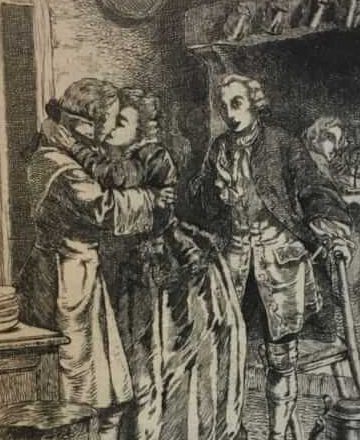Perversion can never be stripped of shame.
Sexual Suicide, Again

The case of pornography.
The Supreme Court mostly ruled out censorship of pornography between the 1950s and early 1970s as skin magazines, seedy video stores, and racy novels began to proliferate in mainstream public life. Then along came internet pornography, which the Court also blessed with First Amendment protection in ACLU v. Reno (1997).
We are now over 60 years into our experiment of legalizing pornography and about 20 years into the era of unregulated internet porn. In a report just out from Heritage Foundation, I ask: what have we learned?
More and more every year, if we are willing to look. The most prominent arguments for deregulating pornography came from liberals who demanded a nonjudgmental framework of rights for all. Liberal arguments have been exposed as window dressing for the deeper defenses of pornography from sexual liberationists. Sexual liberationists thought tender monogamous relations were repressive, whereas (they hoped) emancipating sexual diversity and perversity would foster human happiness and freedom.
While their arguments were not totally contradicted by events, liberationists told pernicious half-truths and their reforms yielded inhuman results.
Liberationists and liberals bang the same drum no matter the circumstance, no matter the evidence. Liberals abet liberationists in getting rid of old, supposedly restrictive laws in the name of neutrality. This allows liberationists to sew their new ethic into the fabric of public law and opinion.
Conservatives, meanwhile, are befuddled. Their arguments in support of regulation seem overwrought, if not hysterical. Conservatives must retool in the face of decades of defeat.
Lessons from the First Censorship Debate
Liberals have traditionally drawn their arguments about porn from the First Amendment, which, they believe, protects “free expression” and not just free speech. In the first era of the porn wars, before the internet, they argued that the Constitution as a whole was made for people of fundamentally different views, including different views about what appropriate literature or art was. Some prefer Scarlett Letter, others Fanny Hill (aka Memoirs of a Woman of Pleasure). Whatever.
According to liberals, therefore, laws cannot restrict “free expression” unless expression causes “social harms.” William B. Lockhart and Robert C. McClure, two influential University of Minnesota Law professors, supplied the standards for proving social harm under the liberal dispensation in a series of articles during the ’50s. Harms, they argued, must be (a) significant, (b) permanent, and (c) primarily traceable to obscene works in order for those works to be legitimate objects of censorship.
Conservatives defended censorship in the 1950s on this liberal turf and, predictably, they lost. Proponents of censorship like the National Council of Juvenile Court Judges (1954) asserted that pornography caused criminality, “juvenile delinquency” and “acts of violence” including armed robbery, rape, and torture. Scholars such as Fred Wertham in Seduction of the Innocent (1954) asserted the connection between obscene reading material and juvenile crime.
In his famous report on the subject, J. Edgar Hoover affirmed that “we know an overwhelmingly large number of sex crimes are associated with pornography.” Congress established committees during the late 1950s, headed by Democratic Representative Kathryn Granahan in the House of Representatives and Democrat Estes Kefauver in the Senate, to establish the connection between pornographic novels and violent crime. Later, in the 1980s, Attorney General Edwin Meese, author of the last great public effort to take hard-core pornography seriously, issued a report much to the same effect.
Honor must be afforded to these efforts. Concerned to establish that pornography causes social harms which justify regulating it on liberal grounds, conservatives wrongly claimed that pornography directly caused a host of violent crimes. They were laughed out of court until they didn’t even bother trying.
More sophisticated neoconservative critics of liberalism like Harry Clor and Walter Berns thought unregulated pornography harmed society, but not in the ham-fisted way politicos had argued it did. Porn affected people profoundly, they argued, but subtly and indirectly. To end censorship was thus implicitly to promote “self-expression” as opposed to “self-control,” and the supposedly neutral freedoms of liberalism turned out to favor some fundamental views over others.
In the age before widespread acceptance of porn, a legally sanctioned ethic of “self-control” had pointed sexual desire toward marriage. In the age of porn, though, a culture of self-expression encouraged people to see sex as serving pleasure and adult fulfillment instead of enduring, procreative marriage.
Berns and Clor did not win the day. Why? “Self-control” serves some good—and marriage itself was under not a little assault from feminism and sexual liberation theories, among other places. These conservatives thought in terms of “the conditions of freedom”—that is, the social conditions necessary to secure rationality and self-control in a free society. They knew that people had to be rational enough to choose intelligently, but generally they left it up to the people to choose how to live, without prescribing religion or comprehensive good. This respectable, more robust liberalism still mimics the thinner one in subordinating or ignoring the question of what a healthy public teaching on sexuality is and how to enforce it.
Censorship means that some restrictions on freedom serve the interests of happiness and are inseparable from virtue to some extent. These restrictions, based on self-interest rightly understood, expand the vision and interests of democratic citizens—get them to see longer and deeper into their being. Perhaps such an effort cannot succeed without an end like religious faith or marital bliss supported in public opinion.
Lessons from the Internet Era
The 1970s and 1980s seem almost like “the good ol’ days.” Porn was then relatively hard to get and available in clumsy formats. It would almost be a relief, today, to catch one’s son reading Fanny Hill or looking at centerfolds. The game changed when the stigma against censorship met a functioning internet flooded with porn. The ubiquity and compulsive viewing of pornography reveal more clearly its effects. Pornography does not seem to lead to violence or crime. In fact, as today’s libertarian critics of censorship argue, wide consumption of internet pornography coincided with an amazing decline in the number of rapes and violent crimes. This is consistent with the enthusiasms of polymorphous liberationists. The cringey Kronhausens, authors of Pornography and the Law (1958), saw salacious literature as, “more often than not, a safety valve for the sexual deviate and potential sex offender.” Letting off a bit of steam prevents the hydraulic sexual system from exploding. More porn means no BOOM! They claimed to have the patients to prove it.
These defenders of perversity hoped that sexual liberation and frequent release will provide a substitute for virtue or will become the new virtue. Peace, law, and order, they said, would come about when individuals were permitted to indulge sexual fantasies freely. They will not come about through the normal channels of self-control and virtue. Self-control is repression and repression serves authoritarianism or fascism, as Herbert Marcuse held. Occasional masturbation will make a boy less likely to invade Poland!
The following is grounds for deep reflection about male eros: If porn conquers rape and violence, it does so through, metaphorically, emasculating and de-sensitizing men. Pornography has a deadening effect on some men and leads to listlessness, ennui or the spiritual condition of acedia, as Mark Regnerus argues in his book Cheap Sex. Men in this condition become less interested in real women. As a result, many pornography viewers have a more difficult time seeing how sexual assault is different from other assaults. People who watch pornography may shun violence because it is unpleasurable, without genuinely respecting others. Is this progress? Is the porn worth it?
Pascal-Emmanuel Gobry’s recent review article documents these findings. Internet pornography is much more addictive than any previous kind because greater novelty and perversity are always just a click away. This addiction, which as many as half of men suffer from, damages men’s sexuality, their relationships, and the social fabric of which they are a crucial part. Men become less interested in sex with real people (Gobry cites studies showing that erectile dysfunction among men under 40 nears 40%).
As a result, Gobry sees internet pornography as “the new smoking” and “the number one public health challenge in the West today.” Will this smoking gun yield regulation of pornography? Are these deleterious effects, using the formulation from the 1950s which still guides American law, (a) significant, (b) permanent, and (c) primarily traceable to internet pornography? What percent of men would be significant? What does it mean to be primarily traceable? This formulation demands that censors perform impossible feats of scientific jujitsu to restrict a First Amendment freedom. This is the turf conservatives lost the censorship battle on in the 1950s and 1960s. Fighting on that turf is a sure-fire loser.
A Losing Battle
This elite theory of law has, when added to a fast internet, destroyed the conditions for a decent, happy, responsible life—especially among men. Porn is defended as freedom. No one freely chooses pornography addiction, and still today, relatively very few proudly share the details of their role in the pornography industrial complex, whether as consumers or producers. Just as slave owners would have nothing to do with slave traders (as Lincoln observed), porn attorneys would not have their children consort with the scum that head up the porn industry—people who prey on the vulnerability of women and the lust of men. No one hopes that their son or daughter becomes a porn star, though HBO is another thing altogether. The directionless sex idealized in porn is not the story of our lives and is not the story of happiness and virtue.
It is a good sign that we persist in opposing child pornography. Liberationists wanted children to participate in and consume pornography. So Wilhem Reich, author of The Sexual Revolution (1936): “The other ‘morality’ which we reject (abstinence for children and adolescents…etc.) is itself pathological and causes the very chaos it feels called upon to master.” That sentiment was shared among liberationists from Marcuse to the Kronhausens. We consider Reich deranged because children are impressionable and because they might be compromised through repeated exposure. We wish to preserve their innocence for a term. Perhaps, for the same reason, we can be concerned about how porn corrupts adults and especially men.
Our embarrassment and shame are a tip-off that such ground is there to be won—and only this kind of victory is really worth having. Opponents of pornography must subordinate talk of “public health problems” and the “new smoking”—those are arguments used to fight on the liberal turf where, to mix metaphors, the deck is stacked against regulation. Conservatives must make the issue “the conditions of happiness,” not just the “conditions of freedom.” Porn compromises happiness and love—and a free people can, in the interests of happiness, restrain itself through legitimate laws. Porn is a sign of decadence for a great people, not a sign of virtue and health.
A political market exists to connect the decadence of pornography with the great populist movements afoot throughout the West because the issue concerns how freedom and happiness diverge. People may find pornography exciting, but they do not at the same time find it satisfying. That is the opening.
The American Mind presents a range of perspectives. Views are writers’ own and do not necessarily represent those of The Claremont Institute.
The American Mind is a publication of the Claremont Institute, a non-profit 501(c)(3) organization, dedicated to restoring the principles of the American Founding to their rightful, preeminent authority in our national life. Interested in supporting our work? Gifts to the Claremont Institute are tax-deductible.
Aristotle points the way to true virtue through free will.
The American people have become acolytes of a religion of the flesh.
How to find our way out from our culture-wide sex addiction.
Talk of the free market is laughable when it comes to porn.
Pornographic technology has turned sensory overload into sensory degradation.






